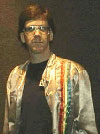INTERVIEW
David Rolfe
 |
Dave
Rolfe working for Exidy, Activision, and others was the first
Intellivision programmer, created the initial Intellivision
protocols, OS, & software; Mattell handheld units; coin-ops
Star Fire and Fire One, 2600, Intellivision,
and Colecovision games including Beam Rider, Major
League Baseball, Frogs & Flies, Blackjack &
Poker, and more… |
MT>
Your 1979 Exidy coin-op Star Fire is very reminiscent of
the Star Wars movie released just prior. The ships look similar
to Tie-Fighters, and even the text font is almost identical to
the Star Wars logo. Was it Exidy's idea to ride the Star Wars
wave, without a license? You certainly beat Atari to the punch!
DR>There's a long story behind the creation of Star Fire.
It started in 1977, when I was just out of college. A friend,
Ted Michon, had graduated two years ahead of me. He was an electrical
engineer and had made some connections in the video game industry;
in fact he was the creator of a game called "Night Driver"
which was first released by a small company named Micronetics,
and later picked up by Atari. In 1977, the movie "Star Wars" came
out, and Ted thought it was the best movie ever, and he wanted
to develop a game in this genre. Ted was then working with Midway,
and he developed a processor-controlled color game unit (at this
time, microprocessors were rare and color was even rarer, and
they had never been combined in a coin unit). Ted asked me to
do the software, which I did. Ted and his wife prepared the graphics,
which had a "Star Wars" look to them. He figured that either we
would license the rights or we would make whatever changes were
necessary to avoid legal infringements. We moved towards completion,
but Midway was not satisfied with the game and we couldn't tweak
it to their satisfaction; eventually they passed on it and Ted
searched for another buyer. Exidy bought the completed game and
built a wonderful case for it, and the rest is history. So the
succinct answer to your question is that Exidy had very little
input into the game play, and Ted was responsible for the Star
Wars look.
MT>
Midway released Taito's Space Invaders which introduced
the "Hi Score"concept in late '78. Your '79 coin-op creation,
Star Fire was the first to allow the player to input his/her
initials and have it proudly displayed. A great concept, which
we have all enjoyed over the years. How did you come up with the
idea initially?
DR>
As Star Fire neared completion, we struggled to find ways
to add to its appeal. In one discussion, Ted asked the general
question of what someone wants to get out of a game. I said something
about the player wanting to go down in history; to get his name
in the books. As I said this, we realized that our processor and
RAM would indeed allow us to save and display the player's name,
if only we could find a way to input it. We struggled with that
for a while, and found a solution using the starship controls.
(I guess it's obvious enough in retrospect, but at the time it
wasn't.)
I couldn't resist tossing in a few special checks for special
friends. When Ted input his initials, the machine responds, "May
the force be with you!". For me, it offers a simple "Hi, Dave.
I hope you are well."
MT>
What type of work did the '79 coin-op submarine combat simulation,
Fire One! Entail?
DR>
Fire One! was developed on the same hardware system that
supported Star Fire. So it was the same kind of programming,
with the advantage that now I had greater experience with the
system. Basically, the system was Z-80 based, running at maybe
2 or 3 megahertz; it created a pixel matrix with a limited number
of colors.
MT>
What major differences were there between developing for an arcade
coin-op and a home console?
Didyou have a preference?
DR>
The arcade games I worked on gave me only pixels to work with,
while the home consoles (Intellivision and Colecovision) offered
sprites which the hardware would superimpose over the background.
So the home console offered a more powerful game engine, assuming
that the game you had in mind could be implemented with a limited
number of sprites.
Every system had its advantages and disadvantages, so I wouldn't
say I had a preference. Except that the Atari VCS was extremely
primitive, and it was a draining experience to make it perform
the way you needed it to.
MT>
You created the Intellivision protocols, software environment,
and operating system. For those of our readers that are not so
technically informed, what are these?
DR>
The Atari VCS didn't have an operating system. An Atari VCS cartridge
contained the entire program for an Atari VCS game. With Intellvision,
we wanted to get more mileage out of our cartridges, preferably
without making them 8k ROMs. An Intellivision operating system
(the "Exec") could help make this happen. The purpose of the operating
system was to do the stuff that every cartridge would have to
do, so that cartridges could spend their limited resources on
game play rather than on mundane tasks. For example, the baseball
cartridge can tell the Exec, "Here's a pixel map of a baseball;
turn sprite #3 into a baseball and move it from the pitcher to
the catcher at a fast speed and let me know when it reaches the
catcher." So a lot of basic functionality (e.g., draw; rewrite;
velocity; collide; time elapsed) ends up in the Exec, and the
top-level direction ends up in the cartridge. And the Exec lives
in a ROM in the main unit, so each cartridge can use it.
In a sense, the Exec created a primitive Object-Oriented Programming
model.
MT>
What was your contribution to the Mattel Keyboard Componant?
DR
> I did a lot of support work for the Mattel Keyboard Component.
It was a monstrous project, 'way ahead of its time, and it's sad
that it barely saw the light of day. (Released in test markets
and cancelled, due to high price.)
Some specifics: I created an operating system for the Keyboard
Component that we called PicSe (for "Picture Sequencer", pronounced
"pixie"). This was like the Intellivision Exec, except that while
the Exec was oriented towards game play, the PicSe created a tutorial-oriented
environment, executing an interpretive language of graphics and
sounds commands while loading and saving data to the cassette
tape. I also created the software to structure the cassette tape
such that large numbers of program segments could be organized
and accessed and coordinated. I also worked on an elaborate music
engine, and a graphics design station.
MT>
Do you recall what Mattel handhelds you prototyped?
DR>
The most important Mattel handheld I did was Football II.
This introduced passing, which was the major improvement over
the original Football. I also developed a handheld pinball game
where the ball's progress was indicated by LEDs.
MT>
Tom Loughry created Steel Thunder (C-64) Dreadnaught
Factor and Worm Whomper for Intellivision and others.
What was your relationship with Tom, and what was it like working
with him?
DR>
Tom Loughry was the best game designer I've ever worked with.
I'm a systems guy by nature, not a gamer. I've got enough game
sense to know the difference between bad and good, and enough
devotion not to let bad product go out the door, but Tom's the
person you need when it's time to conjure a game out of the void.
When several of us ex-Mattel people went to work with Activision,
Tom filled a notebook with ideas which he thought could be developed
into games. We kicked around these concepts for innumerable hours;
one of them was the basis for Beamrider, and another became
Steamroller.
To be clear, a game is vastly more than a single idea. The devil
is in the details; you never know when you start how a concept
is going to pan out, and you always encounter countless roadblocks
which necessitate frustrating re-designs. So I think it's fair
to say that Beamrider is mine; on the other hand, I couldn't
have done it without Tom.
MT>
In addition to the Beamrider, you also completed Steamroller
for the Colecovision, which unfortunately never made it to store
shelves due to the great videogame crash in the '80's. Did you
find it frusterating to work so diligently on a project, and it
never come to fruition?
DR>
Like everyone else, I want to get paid, but I also feel that a
piece of my life goes into any work I create, and I don't want
to feel that this effort was wasted. By the time I was at work
on Steamroller, we all had a sense that Activision didn't
want any more product, and didn't know what to do with it. The
game market had become very very bad. I forced myself to continue
and finish the job, but the process was excruciating. This was
the last game I did.
By the way, it looks like the IntellivisionLives people will finally
be releasing my Colecovision Steamroller game. I'm very
happy about this. Fifteen years late, but better late than never.
MT>
Are you still wearing your Activision Decathlon Jacket
to this day? Does it still fit?
DR>
I started working with Activision just as Decathlon was going
out the door, and I was fortunate to get my hands on a promotional
silver Decathlon jacket. I've still got it, and I put it
on for show sometimes, but I'm not quite sure where one might
appropriately wear it.
David Rolfe certainly had a great deal to contribute,
and Good Deal Games would like to thank Dave for taking time to
entertain us again!
Visit
David Rolfe's
Website and read his biography
E-Mail:
David Rolfe
Are
You Involved with Classic Games?!?
Let us know, and we'll interview you!

E-Mail:
GOOD
DEAL GAMES
GOOD DEAL GAMES HOMEPAGE
Copyright © 2003, GOOD DEAL GAMES

